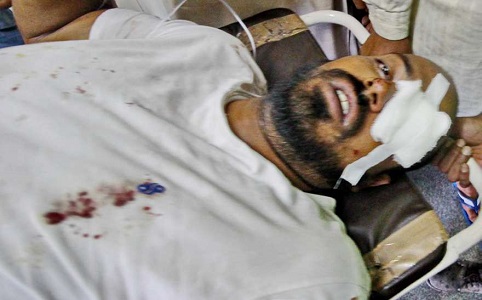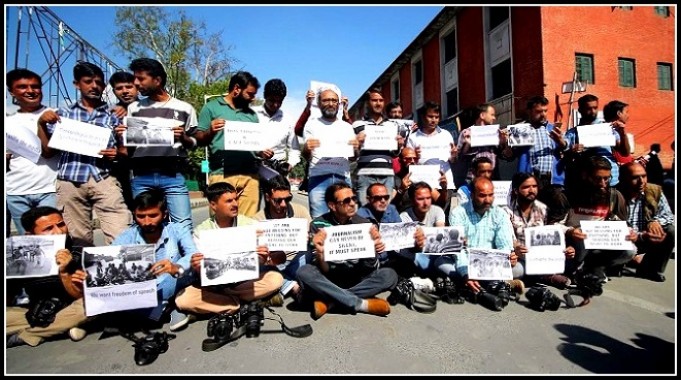Kashmiri reporters caught in the crossfire
A Kashmiri photo journalists' protest on September 3, 2016. Photos on this page by Zuhaib Maqbool
SRINAGAR: Amid all the fire fights, protests, curfews, communication blockades, and restrictions that are making the headlines, one of the most difficult jobs today in Kashmir is to tell the story.
Journalists are seen as “a propaganda tool of the State” and blamed for “hiding the truth”. The public feels disgruntled that journalists aren’t reporting the ‘truth’ on the ground, the government gags the media, and the security forces allegedly beat up local journalists and restrict them from reaching the spots they need to in order to cover the killings and protests.
In the latest attack by protesters on September 20, a journalist was injured in a stone pelting incident in Srinagar. Anees Zargar, who works with a New Delhi-based media organization, was returning home from Uri in North Kashmir where 18 soldiers were killed on September 18.
“I, along with other several media colleagues, was on the way home around 8:30 pm from Uri when our vehicle was attacked with stones by the protesters near Chek-i-Hokersar at Lawaypora. I was hit by a stone in my left arm”, he said. Zargar was rushed to hospital where doctors said his arm was fractured.

On September 4, two Kashmiri photojournalists were covering a rally in the old city in Srinagar when pellets rained down on them. While Muzamil Matto escaped with a few pellets in his head as he ducked on seeing policemen aim guns on them, Zuhaib Ahmad had his whole body, including his left eye, pierced by the minute particles. Ahmad underwent eye surgery and is recuperating at SMHS hospital. The incident was the latest in a series of attacks on media persons by security forces in the ongoing Kashmir turmoil.
Journalists are caught in a bind. Ordinary people label them “agents” while government forces harass them for being ‘Pakistan’ or ‘Hurriyat sympathisers”. Photographers, always the first in the line of action, have borne the brunt repeatedly during the ongoing turmoil that has so far killed 87 people, including two policemen.
On August 8, policemen thrashed photojournalists in Batamaloo after an altercation over the taking of snaps of the protest. In south Kashmir’s Bijbehara town on the same day, photojournalist Muneeb-ul-Islam was allegedly assaulted by security personnel while covering a stone-pelting incident. Senior photographer, Farooq Javed Khan, said policemen presume photographers are mob inciters. “That’s wrong. Clashes happen without us in the spot,” said Khan.
At Srinagar’s SMHS hospital where injured civilians have been admitted, journalists find it difficult to speak to the victims or their family members. People refuse to talk and often ask journalists to leave. “This sometimes leads to terrifying situations. On July 10, three of us - I, along with two more photojournalists - were beaten to pulp at SMHS hospital by enraged people who first labeled us as CID agents and then for working for Indian media houses”, said Daanish bin Nabi, an editor with Rising Kashmir. A reporter with the Indian Express and a senior photographer with an international photo agency also faced the same fate at the hospital.
Most journalists, however, keep trying to report, at times risking their lives. During the longest curfew in Kashmir’s history, journalists have often got into heated exchanges with the security forces as they travelled across restricted areas of the city. Once travel became impossible during daylight - because the streets have become a battleground between the protestors and government forces - they moved around in the night to collect stories. Then the government imposed a night curfew as well.
Nabi adds:“Night curfews add to our daily problems. My two senior editors at Rising Kashmir, Faisul Yaseen and Adil Masood, met with an ugly incident on the evening of August 18. Even before they could reach near the barricade at Sanat Nagar, forces standing there yelled at them, “either go back or we will shoot”.
This distrust of journalists means that the passes issued to them by the administration aren’t entertained and reporters are regularly harassed on the road. There are several instances where journalists were beaten up or their vehicles damaged.
On 20, August, the security personnel associated with paramilitary Sashastra Seema Bal (SSB) late on Saturday night aimed guns at the staff of a local daily shortly after they left home from their offices in Srinagar. Greater Kashmir’s senior correspondent Abid Bashir, along with Kashmir Uzma senior correspondent Bilal Furqani, and another staffer Shafqat Ahmed, were stopped by SSB men at a crossing near the Radio Kashmir building.
"They shouted at us and asked us to go back. We told them that we are journalists and showed them our curfew passes. They became more furious and refused to entertain the curfew passes. They aimed their guns at us,” the terrified staffers said after the incident. "It was only after we called a senior police officer that we were let off.”
On August 17, 25-year-old woman journalist Sumaiya Yousuf was allegedly abused and beaten up by an IPS officer and his team at Jawahar Nagar in Srinagar. “I had filed my story and was on way home. My mother called, asking if I could buy some vegetables because there was nothing at home. I saw a shop in Jawahar Nagar and stopped to buy some vegetables. The moment I began to walk back towards my car, the officer and his men jumped out of their Rakshak. First, they started beating up the shopkeeper. Then they hit and abused me,’’ said Yousuf.
No journalist body has come out to show solidarity with her or highlight the troubles faced by the reporters in Kashmir. “Journalists walk a tightrope in Kashmir,” said Iqbal Mir, a reporter with a local daily. For Mir, there is nothing new in the security forces targeting journalists. “What’s new is the common Kashmiri’s anger against the media,” he says.
Irfan Quraishi is a Kashmir-based broadcast & multimedia journalist. He has previously worked for Day & Night News and Kashmir Times. He tweets @ irfanquraishi85.







